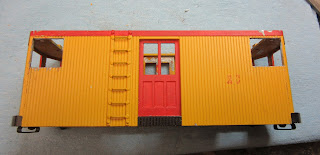When choosing windows to be installed in the sides of the car, remember this car due to its use as a wrecker or repair car; would have bins for small parts and supplies, ropes, chains, etc. installed along the interior of the sides. The larger the windows installed in the sides, the less supplies and equipment can be stored in the car.
Before the glazing is glued in place. Other work on the model had to be done. This type of car can have couplers. Usually the type of coupler used was the Van Dorn coupler. The Van Dorn was a common link and pin coupler found on streetcar lines.
As part of the models and parts available when Pittman was making not only small electric motors but also models in which the electric motors could be used was a working Van Dorn coupler. In the 1950's Wagner had the same Van Dorn coupler in his catalogue. At that time I picked-up a couple of the coupler sets. They were installed in the brass open bench models I had finished. Then the couplers were no longer available.
Sometimes parts come broken or bent. If possible obtain more than you need. The coupler pockets cannot be repaired. The one coupler pocket with the broken loop for attachment to the coupler shank can still used. With the pin in place the pocket can be glued in place.
At a trolley meet last fall a vendor had a few sets of the Van Dorn couplers I was able to obtain. This allowed me to add them to the model of the work car plus another model of the same era. The photos show the installation of the couplers on the model.
One comment on the installation: Since the point of installation would be where a large hole in in the underframe of the model, small pieces of brass were installed to the cast metal frame. This way the 0-80 screw used to mount the coupler shank be screwed into a material that will hold the threads. Styrene is used for spacers only where a strong metal is under the styrene to hold the threads.
The painted, not squarely installed cross-piece in the left is for mounting the power truck. The coupler carrier was glued in place. The coupler shank is mounted with screws.
Next comes the decals. Microscale and Micromark have decal paper for computer printing of decals. Carefully follow the instructions of the manufacturer of the decal paper. With newer computers and printers a large number of fonts are available. The program "Word" will allow you to have a number of printing the letters.
The only limitation is that you will not be able to print in white or the metallic colors of gold, silver, etc. unless you have a special printer.
Once the information you are interested in having is printed on the decal paper, it needs a coating of a material to protect the printing procedure the installation of the decals. Microscale makes Micro Liquid Decal Film which can be painted on using a brush or sprayed. A very thin coat is required. If you have problems spraying the Decal Film, isopropyl alcohol can be added by the drop to thin the Film. Only a small amount (1-2 drops)of the alcohol is needed. A 91% solution of isopropyl alcohol is available in most pharmacies.
Microscale's Micro Sol was used to soften and set the decal film. Sometimes it takes multiple applications of the Sol to get the film to go into the lines between the boards. A new razor blade can be used to cut the decal film to get the film into the lines.
The glazing for the windows made from 0.015" clear styrene. The clear styrene was cut and filed into the correct size. My favorite tool to file plastic is an emery board. Model window glue (A diluted clear water soluble caulking.) was used to keep the glazing in place.
The "EMERGENCY" lettering is a special feature of Word. Letters can be outlined in a different color. Outlining a letter in black gives the letter more character.
The headlight lighting is directional using diodes. An operator was installed after the photo was taken.
More C&U service cars in the next Post.
Cheers,
Ed




















